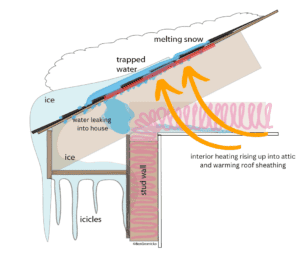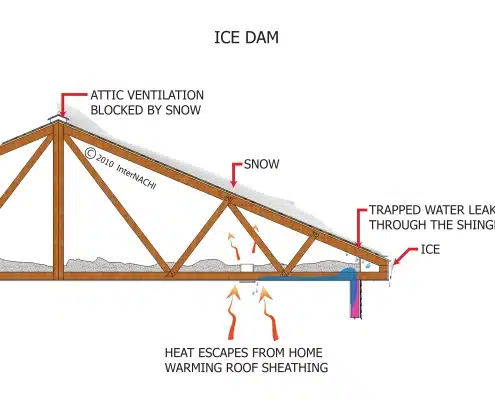What is an Ice Dam?
If you have a leak in your house, and your roof surface is covered with snow, there is a good chance you have an ice dam. So, what is an ice dam, what causes it, and how do you deal with it?
An ice dam is ice build-up at the edge of the roof that dams the drainage of melted snow. The dammed water from melting snow then leaks under the shingles, onto the roof deck, and finally, into your home.
What Causes an Ice Dam?
The root cause of an ice dam is insufficient attic insulation and ventilation. An introductory physics principle is that hot air rises, and cold air sinks. A more accurate description is that hot air is less dense than cold air and floats on top of the cold air.
So, hot air rises from the living space and into the attic space. This warm air creates a warm roof melting the bottom of the snow. Then the melted snow starts draining down the roof.
However, a portion of the roof overhangs the exterior walls. These overhangs are called the eaves and are made up of the soffit and fascia. The roof eaves are not affected by the heat loss from the house and remain cold. As a result, as the melted snow water passes over the eaves, it refreezes, and an ice dam forms.
As more snow melts, the melted water accumulates and eventually leaks into the house, causing interior damage.
How Do You Know if You Have One?
As discussed, the formation of ice dams occurs at the edge of a roof, where the roof overhangs the exterior walls. As a result, leaks and water stains almost always occur on exterior walls.
If you have a leak at an exterior wall after a heavy snowfall, it is likely the result of ice damming.
Ice Dam Prevention
Because of their poor insulation, older homes are more prone to ice dam problems. The best way to prevent them is to seal air leakage points and improve the insulation and ventilation in the attic.
Attic air leaks occur at any penetration through the ceiling. For example, air can leak around the openings of lights, fans, and duct vents. You’ll need to go into your attic and use spray foam around all penetrations including plumbing vents. Caution: do not use spray foam around NON-IC recessed lights.
However, the biggest area of heat loss is usually the attic hatch or stairs. Attic entry insulation covers are a great and cost-effective way to prevent ice dams and save energy.
Next, you’ll need to ensure you have proper and sufficient insulation. You can use the chart below to assess your insulation. In addition, most hardware stores offer free insulation blower rentals if you purchase insulation from them.
Calculating ventilation is a bit more complicated.
Building codes require a minimum of 1 square foot of ventilation per 300 square feet of ceiling. Your roof ventilation comprises gable vents, ridge vents, and soffit vents. I wouldn’t worry about getting exact measurements. A reasonable estimate will suffice. Air sealing and adding attic insulation are feasible projects for most homeowners. However, improving attic ventilation is a bit more complex. It typically requires making or enlarging openings in your soffit or roof.
Do not install an attic fan to increase ventilation.
Other Preventative Measures
Dirty gutters can increase your chance of ice dams forming. A ridge of ice will form if the melting snow can’t drain off the roof edge because of dirty gutters. Make sure you keep your gutters clean.
In addition, bathroom fans terminating in the attic can increase the chance of ice dams forming. Bathroom fans should terminate outdoors, but often they terminate in the attic. This can warm up the attic and the underside of the roof, melting the snow. Evaluate your attic for any fan ducts and make sure they terminate outdoors.
How to Remove Ice Dams
Ice dam removal is a simple but difficult process. First, you’ll need to remove the snow from your roof. Use a roof rake and some extension poles to remove the snow from your roof. It’s ok to leave about an inch of snow to avoid damage to your roof shingles. Next, toss some ROOFMELT tablets around the ice dam problem area. These calcium chloride tablets melt snow and ice without damaging your roof.
Caution: Using regular sidewalk or driveway salt to melt an ice dam will ruin your roof.
As an Amazon Associate I earn from qualifying purchases. So I provide you with you relevant knowledge and products to make extra money 🙂





